The Problem of Scarcity 2: It’s All In Your Head
September 20, 2009
We’re talking about the Problem of Scarcity:
September 13, 2009: The Problem of Scarcity
One of the problems in the U.S., regarding the Problem of Scarcity, is that Americans believe in the idea of haves-and-have-nots. Winners and losers.
Unlike football, this is not a game where 50% are winners. Maybe 5% of the people are winners, and 95% are losers. But even our $250,000-a-year family is not really a winner. They’re getting by. Not losing, but not really winning. Do husband and wife pour themselves a drink and say: “Whew! We made it! We won! We’re done! This is fantastic! We’re so lucky!” No, it’s back to the salt mines on Monday. All those debts to pay. And still nothing left at the end of the month. So, maybe only 1% are winners.
Americans are intoxicated by this idea of winners-and-losers, even if they don’t like the results. Look at the TV show Survivor for example, or its many knockoffs. One winner, and lots of losers. This is supposedly “reality” TV. There are dozens and dozens of shows that are repetitions of this basic idea. When you leave Americans on their own, this is what they create over and over. Kinda Lord of the Flies-ish don’t you think?

“That’s so sicko, I wish I invented it!”
Beelzebub, the fallen cherubhim known as the Lord of the Flies.
I saw a similar sort of show on Japanese TV. They put a couple of young guys on a deserted island, off the coast of Japan. Their goal was to get off the island, and return to the mainland.
This was much closer to real reality, as opposed to an arbitrary winners-and-losers game being held in a remote location. The two fellows had nothing to begin with. They ate by picking up raw shellfish out of tidepools. They built some crude shelters out of sticks and leaves. It took them weeks to create fire. Eventually, they created a simple raft, and paddled it ten hours across the ocean to the mainland. It took them over 100 days to leave the island.
The point is, they worked together, and succeeded together. Both were winners. You never see a show like this in the U.S.
They might not have made it to the mainland at all if they refused to cooperate, and instead spent all their time trying to kick each other off the island.
(Those two guys later took a pedal-boat from India to Indonesia, which took over a year.)
Even though Americans don’t really like the results of this winners-and-losers philosophy — they are mostly losers — they don’t want to give it up. They are like battered wives who refuse to leave their violent husbands.
I want to emphasize that this is mostly an idea. We could also adopt the idea that we could all win together. We could all be winners. Doesn’t that make more sense?
I have to drag this out into the open, because when you make let’s-all-be-winners proposals to Americans, it tends to make them uncomfortable. They have this funny feeling that it’s not the way things should be. Now we know why.
When you fully understand the idea of winners-and-losers, and are able to extricate yourself from it at least on a mental level, then shows like Survivor become very stupid. Instead of being fascinated by: Who Will Win? Who Will Lose? — which is what people who are enthralled by the winners-and-losers game think about during all their waking hours — you understand that the game of winners-and-losers has no real winners. You might as well watch people beat themselves in the head with a stick. (The game of winners-and-losers is more like people beating each other in the head with sticks, which has the same ultimate outcome.)
The Problem of Scarcity is only solved when 80% (could be more) of the people can say: yes, we have what we need and want. In fact, we have much more. We are so lucky to live in this wonderful place in this wonderful time. That doesn’t mean we all have to be alike. It means that instead of a society of haves-and-have-nots, it is a society of haves-and-have-mores. There are people with enough, with plenty, with more than plenty, and plenty more than plenty.
Which is the way it should be in the wealthiest society the world has ever seen. Don’t you think?
* * *
I’ve been talking about these themes for a long time.
July 9, 2007: No Growth Economics
I don’t think the Problem of Scarcity can be solved without also adopting the Traditional City. Because, as we saw, it’s not really about stuff, it’s about stuff-that-doesn’t-suck. Which tends to translate, in a practical sense, into good neighborhoods. Unfortunately, Suburban Hell, 20th Century Hypertrophism, and 19th Century Hypertrophism don’t produce good results. You don’t get good location-location-location by using these techniques. You can’t create heaven on earth with the blueprint for Suburban Hell. Ob-vi-ous-ly.
It soon became apparent to me that we would have to start by explaining exactly what a Traditional City, a 20th-Century Hypertrophic City, a 19th-Century Hypertrophic City, and Suburban Hell actually were, so we would understand what we were talking about. So far, it’s been about two years, and we’re not done yet. (I hope to Take a Trip to Suburban Hell before the end of the year, and we still need to look at the big-city version of 19th Century Hypertrophism.) I started just with the aesthetic notion that Traditional Cities look nicer. You can look at the photo and say: Oh, how nice! Kinda simple. Well, you have to start somewhere. Now, we can look at the same subject from a little different angle, through the lens of the Problem of Scarcity.
I went on an on last week about alternative housing arrangements. Let’s just put it this way: what if you could buy a perfectly nice, comfortable place, in the right sort of neighborhood, for 1x your annual household income? Whether you make $25,000 or $100,000, you could buy a place to live (that doesn’t suck) for that price. If you make more than $100,000, you can buy the $100,000 place and pay cash. Of course, it would be rather modest by today’s bloated standards. But, as we’ve seen, it can be perfectly functional and actually quite charming. You would have to give up some square footage, but that in itself is not so difficult. You would still have the location-location-location, which is really the important thing.
If our median income is $50,000, that would mean the median house price is $50,000. That translates into about 500 square feet, which can be rather plush for a single person or a couple, and could be split into two or even three bedrooms if necessary. 7×10, or 70 square feet, makes a perfectly functional bedroom. It’s about the size of that Tumbleweed guy’s whole house! (He lives in the 89sf “Epu” model.) Maybe some people would want to spend more than that, even up to today’s standard 3x income, but the point is that they shouldn’t feel the need to. It should just be a sort of hobby, the way other people spend big bucks on art or orchids or old records, or something like that.
I’m talking about the median $50,000 household (not individual) income because that’s who we are. The median we. Yes, any individual can make more money than that, but if you want to solve the problem for everyone, and not just be a winner in a sea of losers, then you have to deal with it at that level. The median income today is around a mid-1950s level, when expressed in gold oz. It has gone nowhere in fifty years. And what’s wrong with that? So, we need to think about a lifestyle where we can live very happily and comfortably at that level, and still be able to easily save 30%+ of our income if we choose, like Chinese or Malaysian people do. Let’s put numbers on it: $50,000 in gross income is maybe $40,000 in disposable income. Take off 30% from that, and you have $28,000. So, we’re talking about a cushy, fulfilling, exciting lifestyle for $28,000 a year for the household. Let’s not forget those below the median: even people with gross income of $30,000 or so should enjoy all the fundamentals of our fulfilling and exciting lifestyle, with maybe a little less cushyness. But not scarcity. If you make more than that, well great. Have a good time with it.
One times income for a shelter is actually rather high. Back in 2007, I brought up the example of the Native Americans, who could make a decent, respectable shelter in about two weeks of work. That’s why they didn’t have a Problem of Scarcity, even though they didn’t have very much in the way of material things. One times annual income, or 52 weeks of work, is actually 26 times more burdensome than that. Only a stupid white man would even consider the idea of thirty years of debt slavery.

“You guys are stone nuts.”
Could you get a place for 6-months income? Shouldn’t be a problem for those making $100,000 or more.
At 1x income, you could pay the thing off in five years. That might be nice. Yahoo estimates that a 5-year $50,000 mortgage would cost $1,042 per month, including taxes and insurance. Then, after five years, you would own the place and would only be paying the taxes and insurance, of maybe $200 a month or less.
(A $150,000, or 3x the median income, 30-year mortgage has an estimated monthly payment of $1,126.83. So, the 1x income mortage is not only cheaper per month, you get 25 extra years of freedom.)
The second issue is transportation. The Traditional City is a place where you don’t have to own a car, and indeed you don’t want to, because it is a pain in the butt and serves no real purpose. Instead of $5,000-$11,000+ per year per car in transportation expenses — which is a rather large chunk of our $40,000 disposable income don’t you think? — you have about $1,000 per year (per person) for your $80-a-month subway pass.
No more car loans, no more insurance, no more can’t-have-any-more-drinks, no more road rage, no more looking for parking, no more getting ripped off by the mechanic, no more getting pulled over for driving-while-black, no more automobile baloney.
Medical expenses should be through some universal state program, and limited to under 8% of GDP per year — like every other developed country on Earth.
Of course our 500sf apartment will be well insulated, with at least 12″ of fiberglass insulation in the exterior walls. The R-48 standard now adopted in Germany should do it. This would cut our heating expenses to maybe $50 a month in the Northeast winter. (A woman who lives in one of those Tumbleweed Homes says she pays $6 a month for winter heat in Seattle, which gets below freezing.) While we’re at it, we will add plenty of sound insulation between apartments, like any civilized person would.
I’ll just assume that the schools are reasonably good. Maybe a voucher system would help. But, probably the thing that would help most of all is if there were more stay-at-home mothers. Which would be the natural result as financial pressures were alleviated.
Can’t you just feel the Problem of Scarcity melting away?
The solution is to make it very easy to obtain what we need and want. After that, it’s all fun and games.
The most important thing is that all the neighborhoods are good. This is the exact opposite of New York City, in which most of the neighborhoods stink, and even the very best ones are sort of mediocre (I do mean the very best, and I do mean mediocre). The Bronx? Queens? Most of Brooklyn? A dump. Even Manhattan is mostly a dump — most everything above 110th street. And west of 8th avenue. And east of 2nd avenue. And the Lower East Side. See what I mean? Dump dump dump. Even the stuff that is not a dump is still kinda dumpy. Don’t even get me started on New Jersey, or Staten Island. So, not like that.
Maybe I’ll get the “you should see my $3m penthouse remodel. It’s definitely not dumpy!” email. I have seen it — or one like it. It’s very nice, but I’m talking about the stuff outside your window. You could also do a $3m remodel of a place in Flushing, and Flushing would still be a dump. You could spend $25m, or $100m, or heck even a billion smackers on your stupid house, and, despite your frantic efforts to compensate, Flushing would remain as dumpy as ever.
We haven’t taken a Trip to New York yet, but you already know the answer: the 19th Century Hypertrophic City tends to become rather dumpy, among other problems.
Of course, we will have a properly beautiful subway system, as you’ll find in any Asian city and most European ones, not the rathole you have in New York. (No “light rail” or any other half-ass fixes either: a proper full-on twenty-trains-an-hour subway system.)
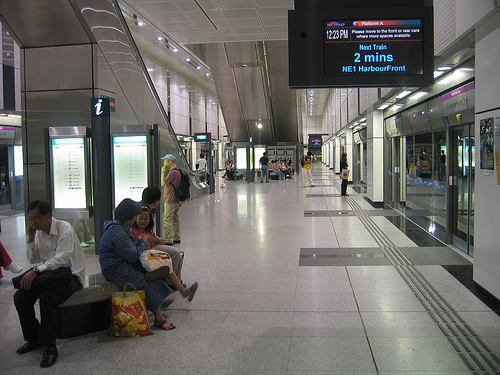
Subway station in Singapore. No other country in the world puts up with shithole subways like people in the U.S.
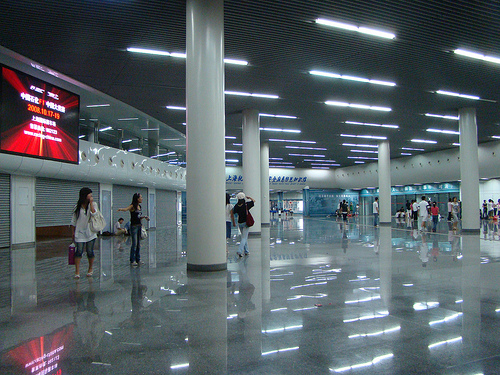
Subway station in Shanghai. China is sooooo kicking our asses.
Since all the neighborhoods are good, we don’t have to work here and live over there. We can live wherever, because it’s all good. That cuts our commute to under 30 minutes. Maybe we can even walk to work.
Let’s see what this looks like.

SONY DSC
This is the French village of Eguisheim again. It was so nice, I wanted to go back. It is a very small village, but you could just as well make a large city (the residential areas) out of this same pattern.
Would you live in a 500sf apartment here, that you could pay off in five years?
And finally be free of your stupid automobile, and be able to walk to work?
Would that be pure fucking torture? Do you think you can handle it?
Do you think you could raise kids here? Grow old here? I could.
This was not made by aristocrats and nobles. This was made by middle-class merchants, maybe during the 17th or 18th century.
The seventeenth century!
How about if we, the Wealthiest Society The World Has Ever Seen, stop beating each other with sticks and maybe just do what middle-class people did in the 17th century?
We might like it.
We could all be winners — together!
I’m getting so worked up, I think I’m going to take a walk around Eguisheim to cool off a bit.
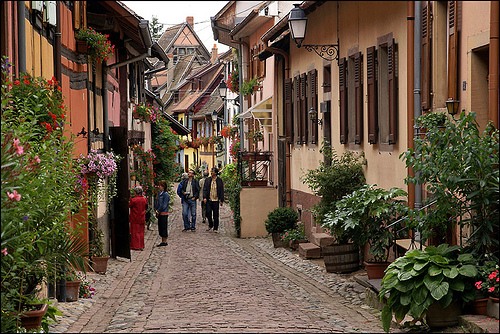
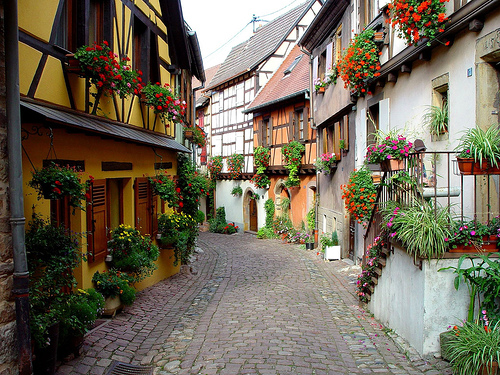


Maybe this is the building where your apartment is.
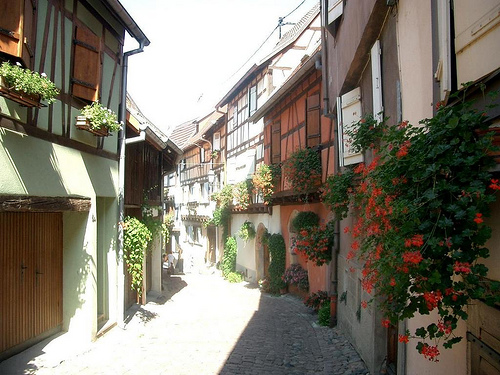
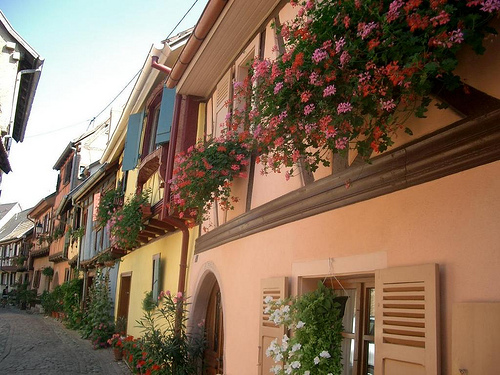
That’s better.
Nice location.
Location location location!
Doesn’t suck, right? Not in the least bit dumpy.
We could all — 80%+ of us — live like this. (It could be 100%, but it is best not to expect perfection.) There is nothing inherently difficult or expensive about it. I could probably teach a class of fifth-graders how to design a city like this. It’s just some Really Narrow pedestrian streets (8-12 feet wide by the looks of it), and simple boxy buildings set side-by-side and painted cheery colors, and no cars. Or, maybe we can create our own, even better version of the Traditional City.
Try to imagine it. A truly brilliant civilization.
I’m imagining a place like this where you can also walk to the beach and go surfing.
Now that would be paradise.

“We made it! We won! We’re done! This is fantastic! We’re so lucky!”

